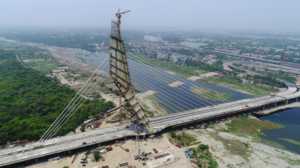Signature Bridge
Coordinates: 28 ° 42 ′ 20 ″ N , 77 ° 13 ′ 57 ″ E
| Signature Bridge सिग्नेचर ब्रिज |
||
|---|---|---|
| Bridge in October 2018 | ||
| use |
Road bridge for Wazirabad Road (NH9) by 2010 |
|
| Crossing of | Yamuna | |
| place | Delhi | |
| construction | Cable-stayed bridge | |
| overall length | 675 m | |
| width | 35.2 m | |
| Longest span | 251 m | |
| start of building | 2008 | |
| opening | 4th November 2018 | |
| location | ||
|
|
||
The Signature Bridge , ( Hindi सिग्नेचर ब्रिज ) is a road bridge over the Yamuna in Delhi , the capital of India . It is to be a new landmark of the city and connects the administrative district of North-East Delhi, founded in 1997, to the city center.
history
The decision to build the bridge was made in 2004; construction began in 2008. The foundation of the bridge was carried out by a company from Mumbai and was completed in January 2014. The structural steel was imported from China . On November 4, 2018, after ten years of construction, the bridge was opened by Arvind Kejriwal , the district president of Delhi. The bridge was opened to traffic immediately after the celebration.
The client was Delhi Tourism and Transportation Development Corporation (DTTDC), better known under the abbreviation Delhi Tourism - a state-owned company that is responsible for tourism promotion and the construction of bridges on Union territory. The construction was carried out by a consortium consisting of Gammon India , the largest construction company in India, Cidade from Brazil and the Italian technology specialist Tensacciai . Concept, detailed planning and construction supervision were carried out by the German engineering firm Schlaich Bergermann Partner .
The construction costs were estimated at 1,131 Crore Indian rupees at the end of 2013 , which corresponds to approximately 135 million euros .
technology
The most important support part of the asymmetrically designed cable-stayed bridge is a distinctive kinked pylon , which now represents the tallest structure in Delhi. It consists of two cheeks that are firmly connected to the roadway girder and unite in the middle to form a common vertical upper part, similar to an upside-down Y. The merged top of the pylon consists of a 20 m high steel-glass structure , which can be lit from the inside and is a landmark of the capital of India that can be seen from afar at night. Both the four ropes of the back anchorage and the two 15 main ropes, each arranged like a harp, are anchored to the pylon. The inclination of the pylon relieves the ropes of the anchoring because part of the force in the main ropes is absorbed by the gravity of the pylon.
In terms of construction, it is a type of cantilever cable-stayed bridge, which has the property that such a bridge can support itself without anchoring on the ground; this is achieved through a balanced distribution of forces in the overall construction. This rarely built, visually striking type of bridge was first implemented by the architect Santiago Calatrava with the Puente del Alamillo in Seville for the 1992 World Exhibition .
The modules of the bridge were screwed together on site, not welded, which was easier for the workforce of the local construction company to handle.
The cable-stayed bridge is part of a newly constructed river crossing with eight lanes parallel to the existing Yamuna Bridge. In addition to the cable-stayed bridge, the crossing includes a 1.8 km long access ramp in the east and a 1.5 km long structure in the west, which connects to the outer ring road from Delhi. The six-kilometer infrastructure project also included a new cycle path .
Individual evidence
- ↑ a b Signature Bridge fast-tracked to link north and east Delhi. Indian Express, December 23, 2013; accessed November 4, 2018 (UK English).
- ↑ a b c Yamuna Bridge at Wazirabad. Schlaich Bergermann Partner , accessed on November 4, 2018 (English).
- ^ Watch: Delhi's Iconic Signature Bridge Is Now Open For Public . In: News18 . ( news18.com [accessed November 4, 2018]).

